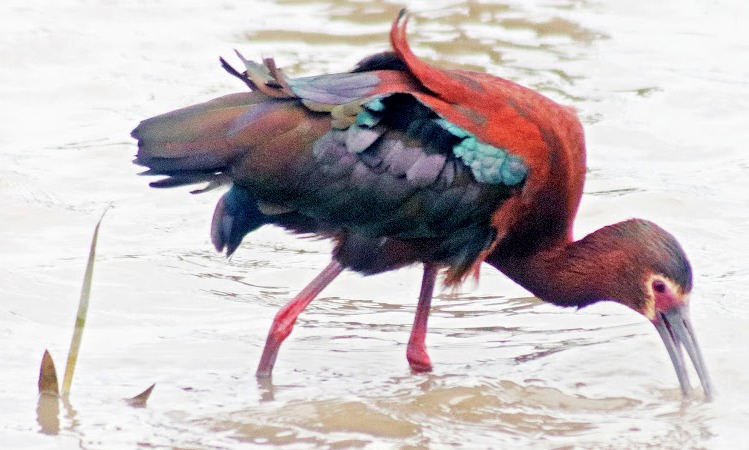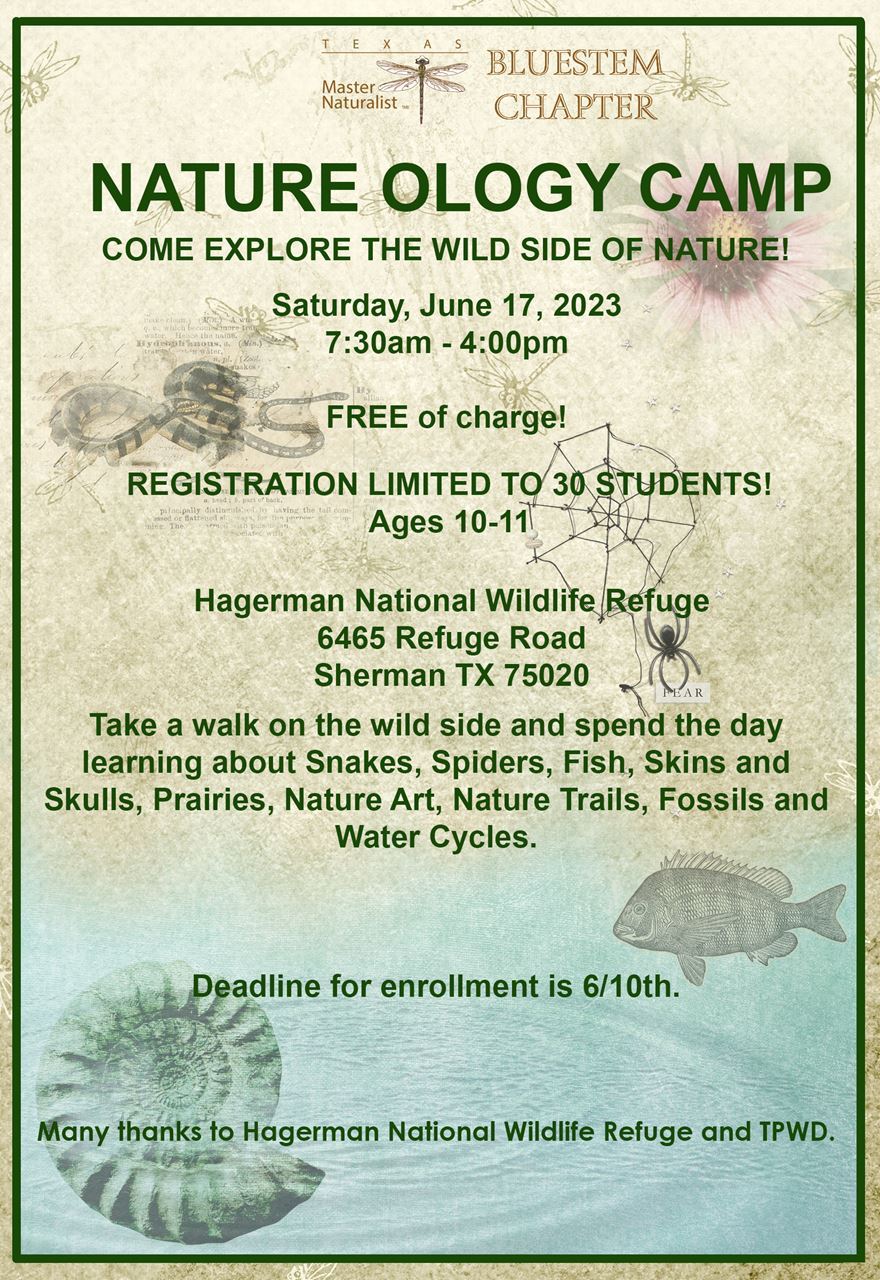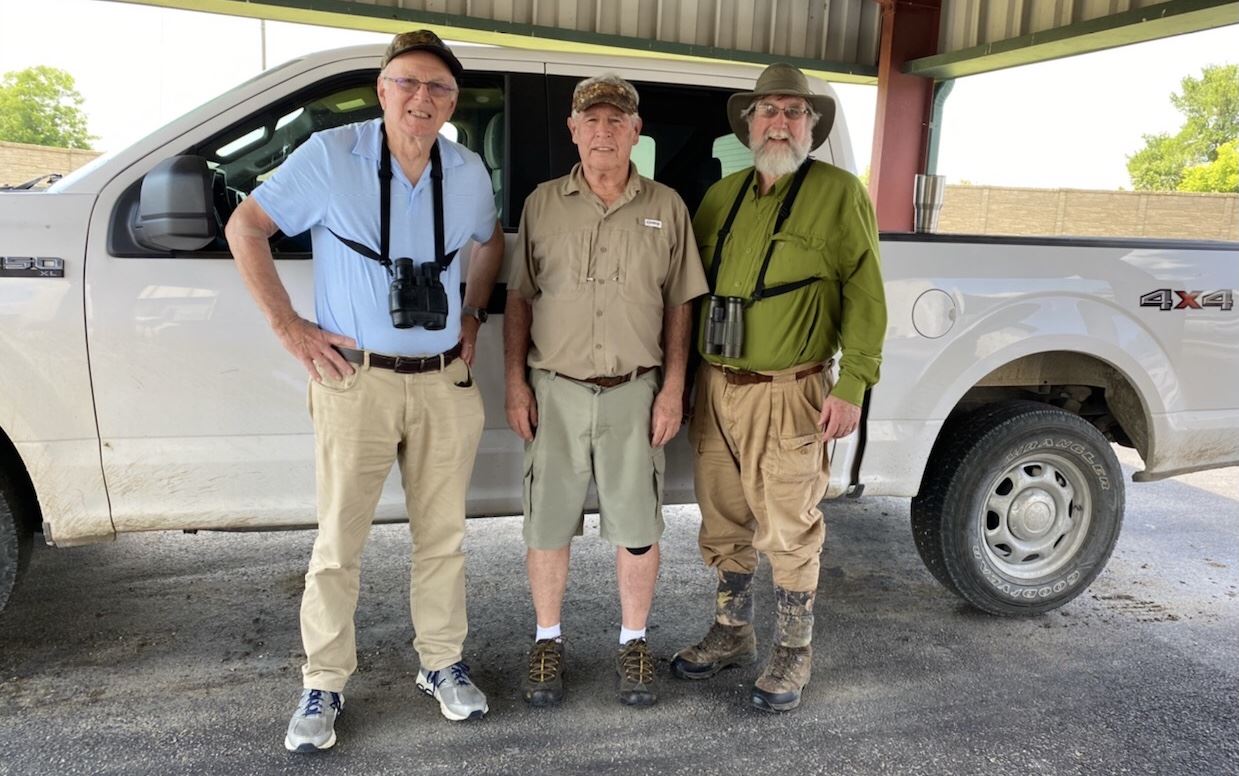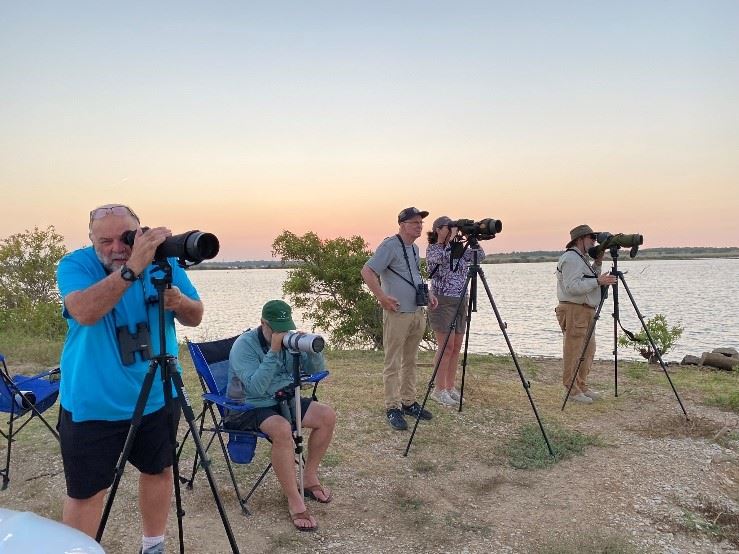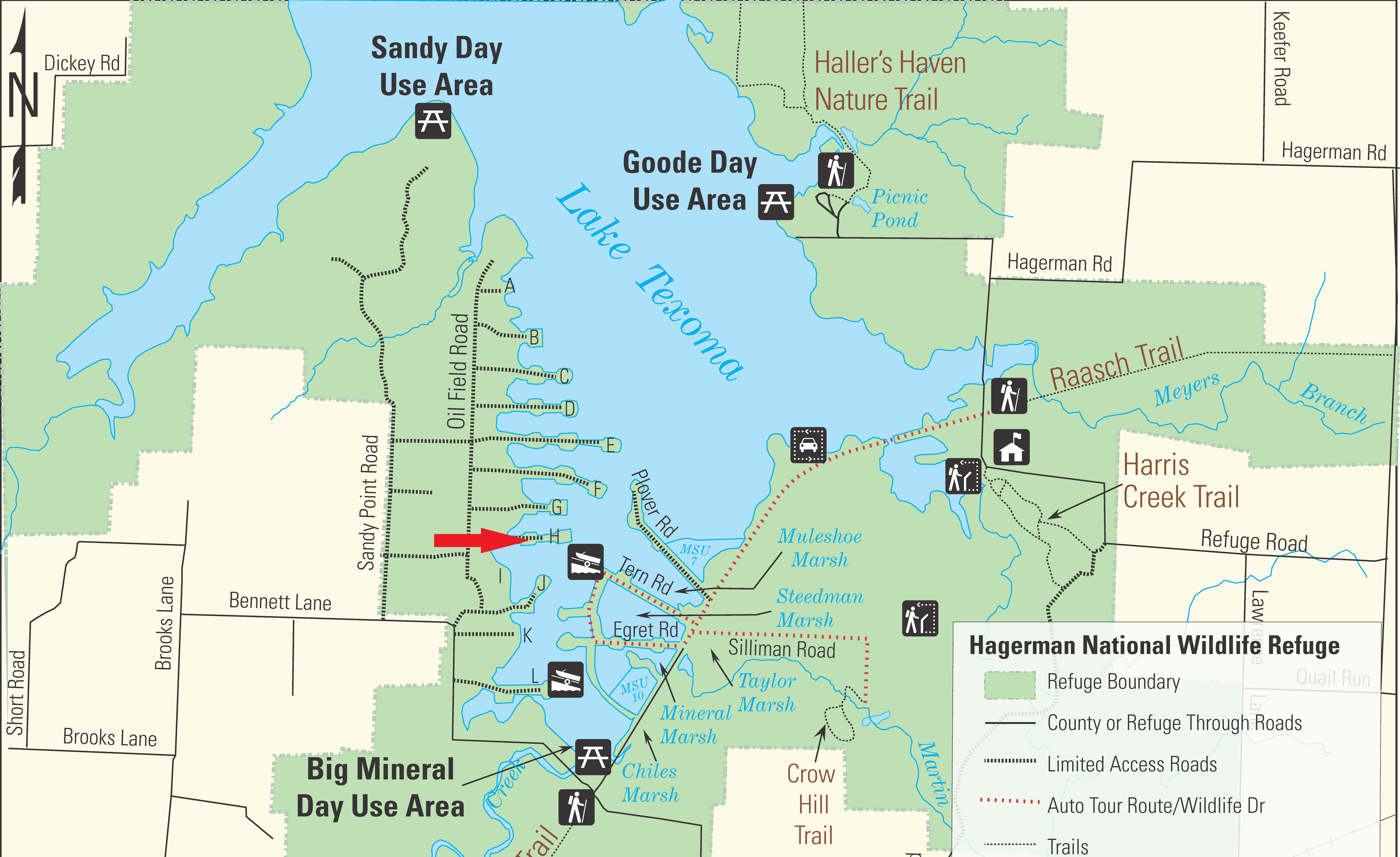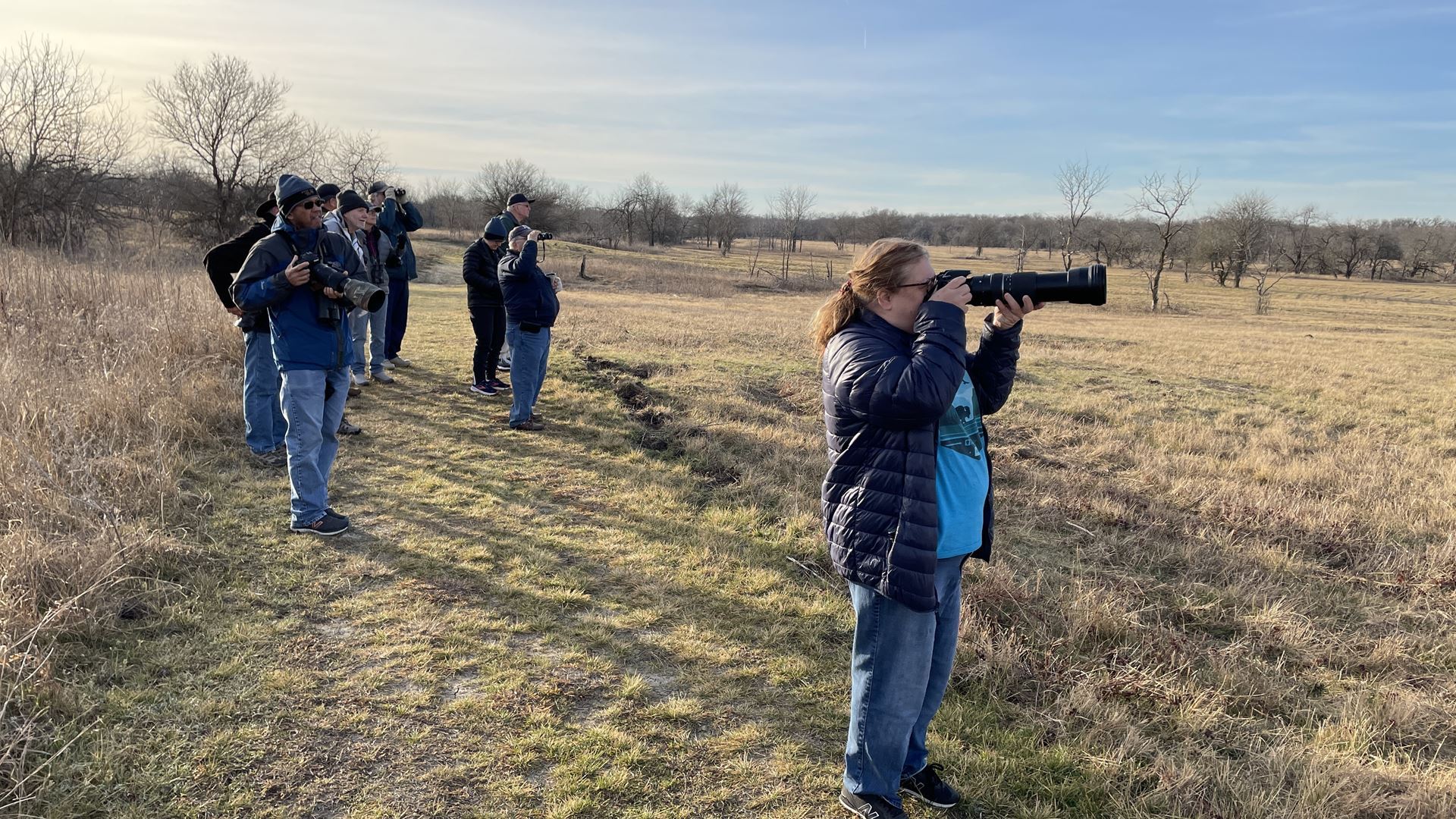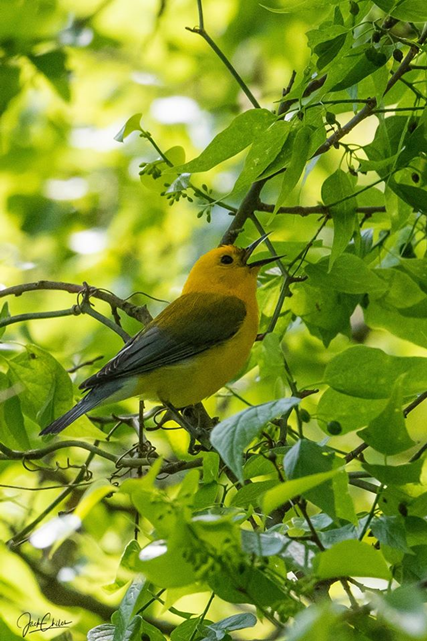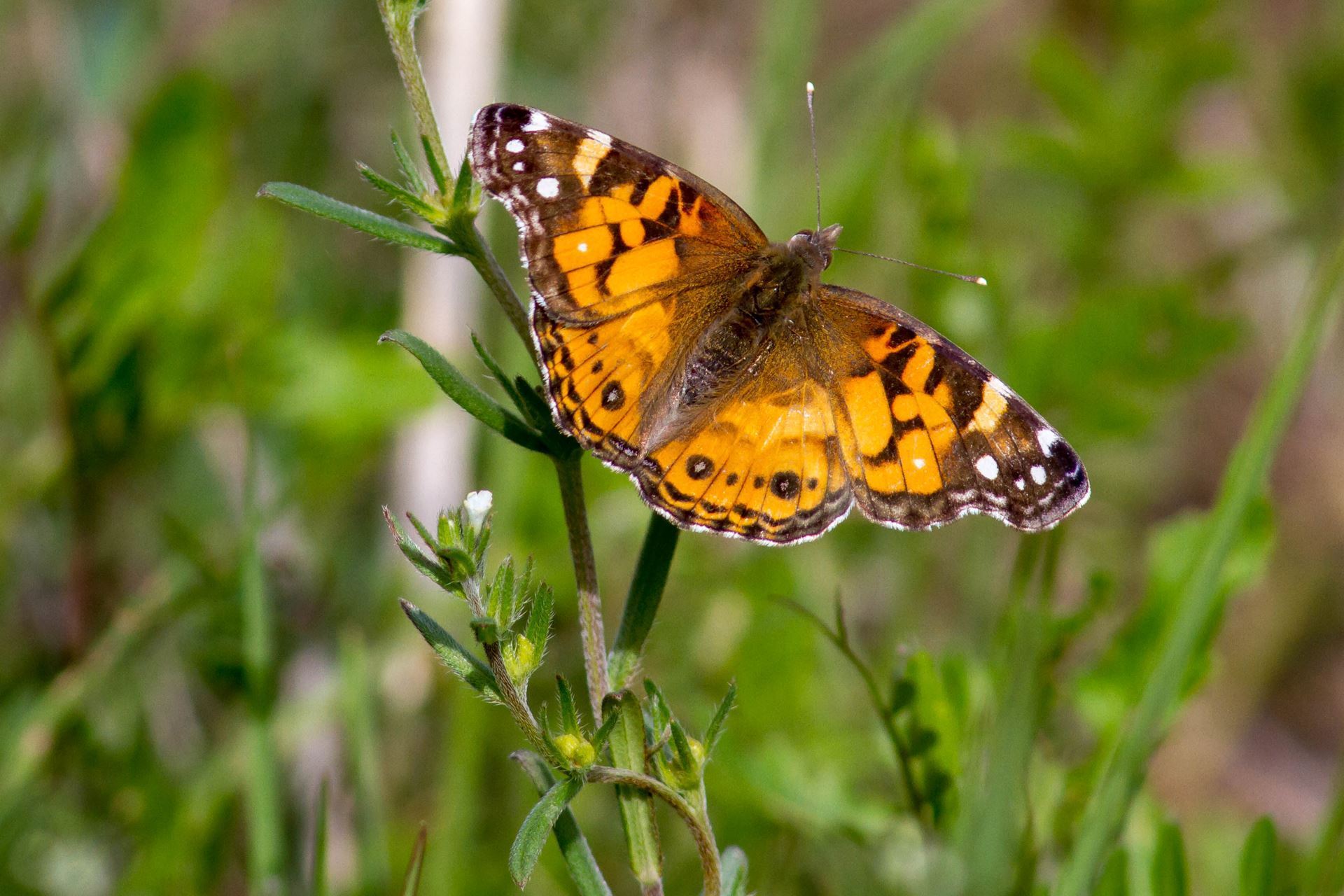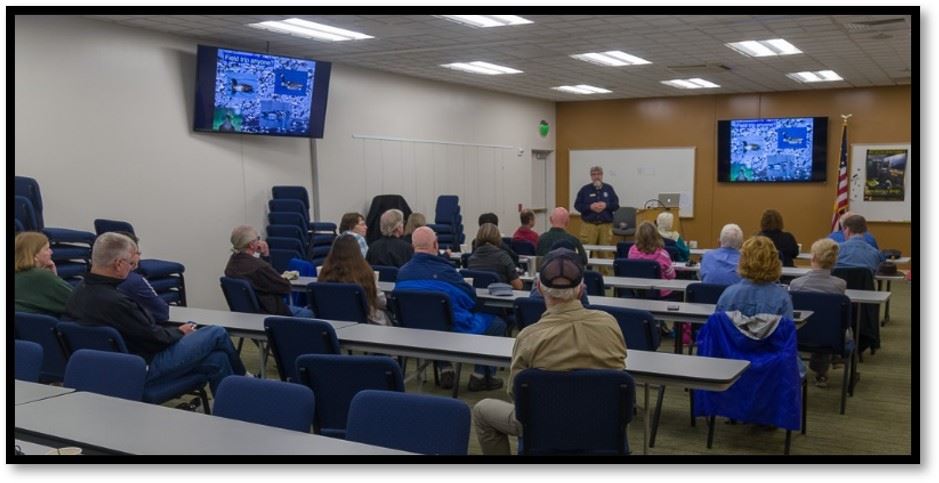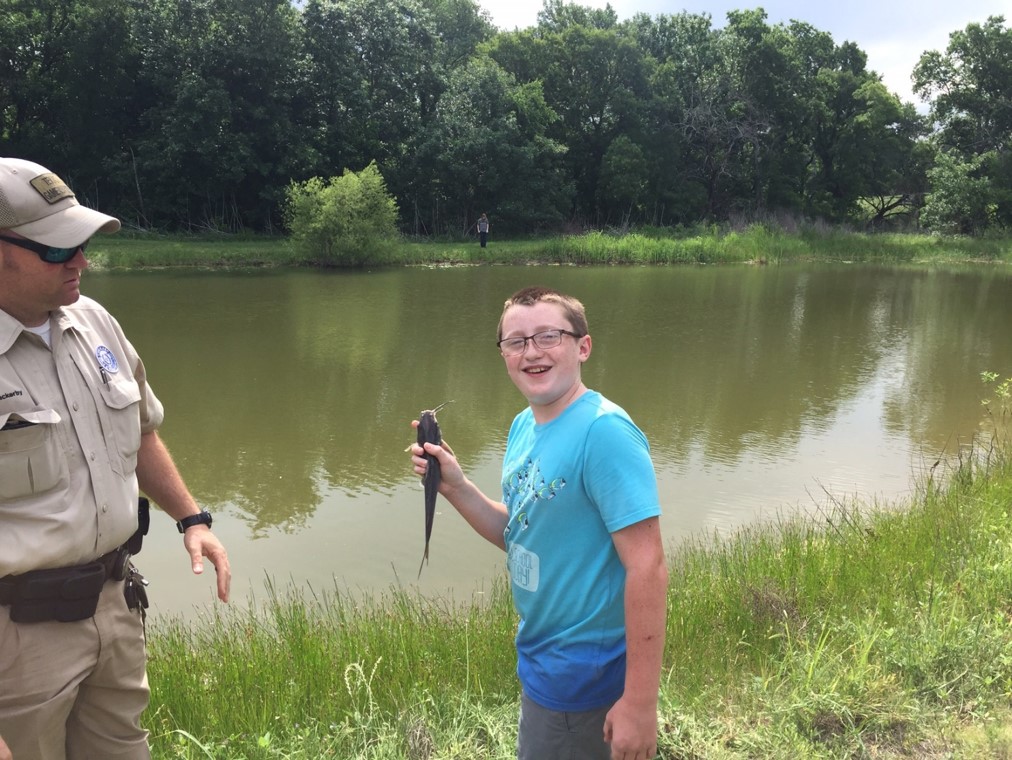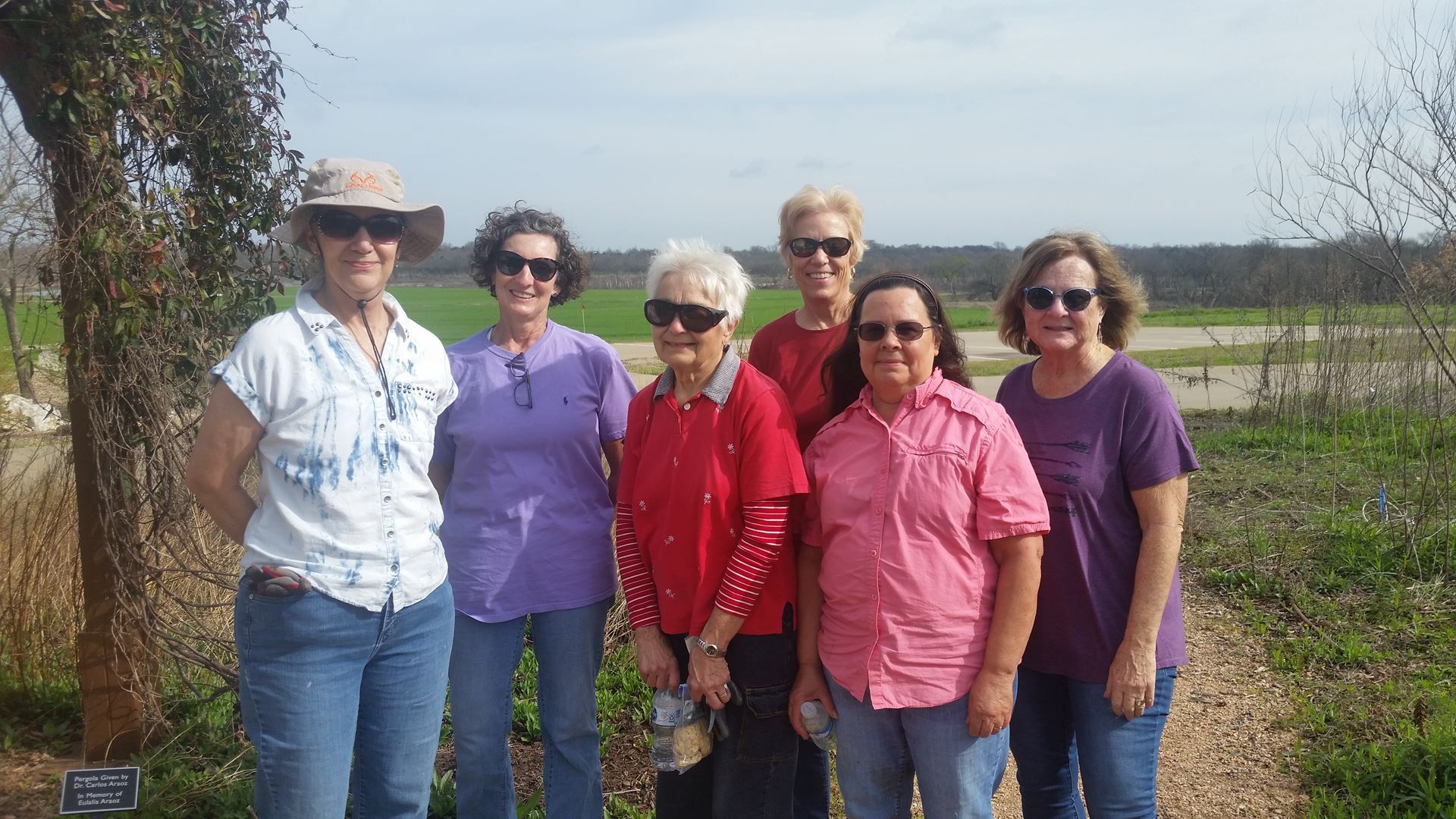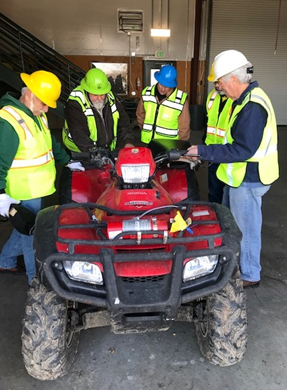A Harbinger of Seasons: The Scissor-tailed Flycatcher
By Renny Gehman
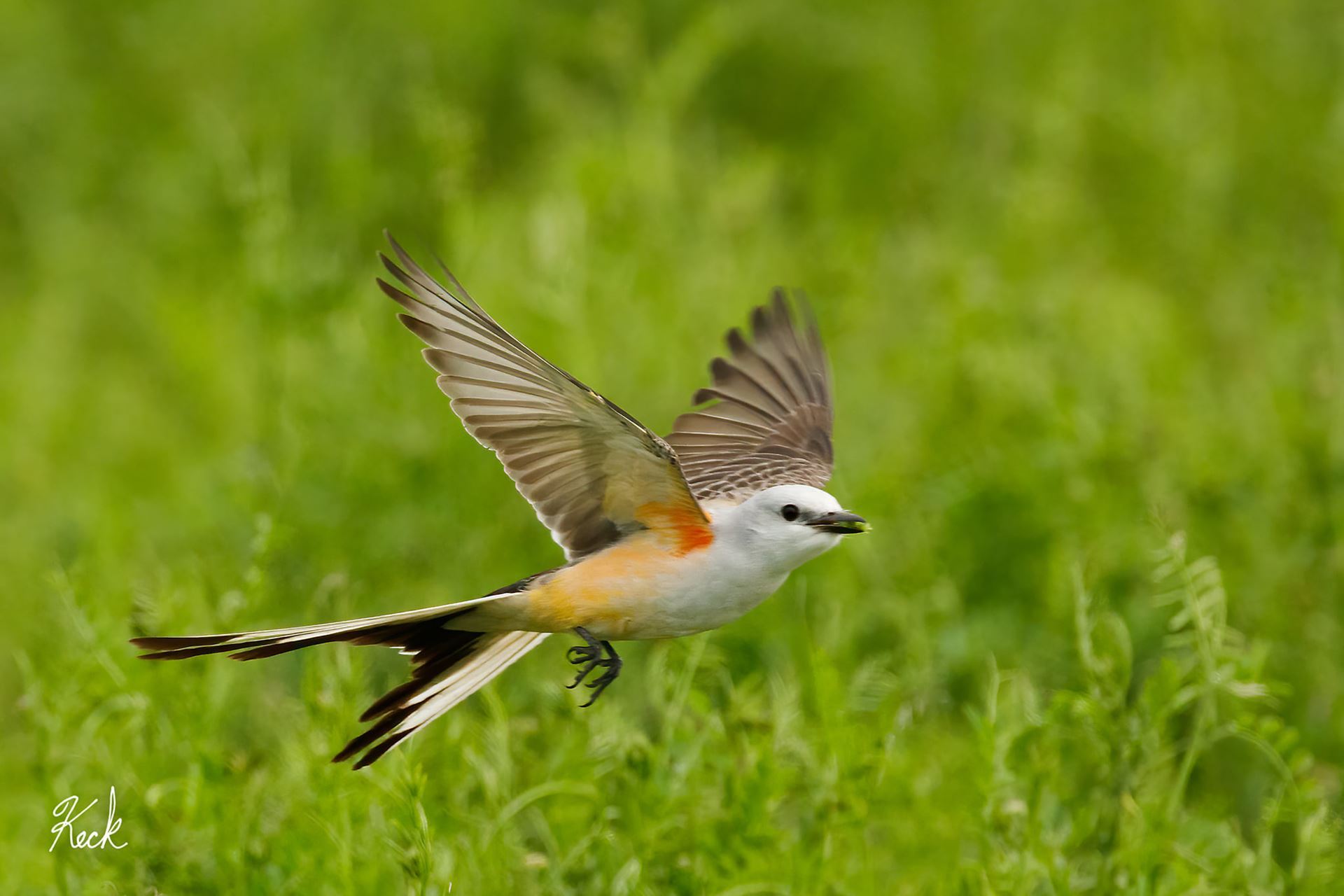
Photo by Trish Keck
When I lived up north, we always looked for robins returning as a sign that winter was ending, and spring had officially arrived—no matter what the weather. But in Texas, robins are seen most frequently in January, which even in Texas is not mistaken for spring.
But Texas has its own spring avian signal: the scissor-tailed flycatcher. This amazingly beautiful bird shows up at Hagerman from late February/early March through May. It is as much a sign of spring as Texas bluebonnets—and just as beautiful. Scissortails aren’t limited to Texas, however; they can be found in open country with occasional trees throughout the Midwest from Oklahoma to Kansas, and ranging into Louisiana, Arkansas and Missouri. Occasionally they venture as far north as Canada and east into Georgia and Florida. But wherever they are sighted, they are one of our easiest birds to identify. No pictures to show Photo by Pam Rendall-Bass Here in Texas they are commonly seen sitting on telephone wires, or resting on roadside fences. But the scissor-tail is never confused with other line-sitting birds like grackles, mockingbirds, pigeons or with their close relative, the kingbird. Why? Well, aside from its distinctive coloring (adults have pale gray, almost white, heads and upper parts, with belly and sides showing salmon-pink while | Plant of the Month: Gulf Coast Penstemon Mother's Day Gifts in the Nature Nook The Mother's Day Garden Walk is May 14th Birding with Jack: The Weekly Bird Census The Refuge Rocks! Programs for Children Tram Tours on the Wildlife Explorer! Gardening, Mowing and Work Crew Visitor Center Volunteers Needed! Subscribe to Our Monthly Featherless Flyer |
the wings are dark brown with white edging and are joined with a red patch at the shoulder) the scissor-tail has one unmistakable characteristic. In fact, most birding books/websites state that a scissor-tail can be mistaken for no other bird—and it’s how it was named. Both male and female scissor-tails have black and white tail feathers which, in the male’s case are actually longer than its body. These feathers can be opened and closed like a pair of scissors—hence, its name. Scissor-tails are acrobatic foragers. They launch from their perch into the air to pursue flying insects like bees or wasps, sometimes dropping to the ground to capture grasshoppers, crickets and spiders in the grass. It’s also often seen hovering with its tail spread, examining the ground beneath, or making abrupt turns midair, using its tail as a rudder, to grab an insect on the wing. With their tails folded, scissor-tails are capable of swift flights, most often seen in their spectacular courtship display. Males climb about 100 feet in the air, then plunge down in an erratic zig-zag, giving a cackling call all the while. He repeats this over and over in the presence of a female, up and down, spreading his long tail in a beautiful display often described as an “aerial ballet”. It is one of the most distinctive behaviors scissor-tails exhibit throughout the spring and summer. |
Fortunately for us birdwatchers, scissor-tailed flycatchers aren’t choosy about where they nest. They build a bulky, cup-like nest anywhere from 7 to 30 feet above the ground on the horizonal limb of a handy tree like a hackberry, mesquite or oak on the prairie, or in a pasture, cropland, a golf course or your garden. But they also often choose windmill towers, bridge supports or the crossbars of a utility pole. Scissor-tails like an open site with some shelter from the |
No pictures to show Photo by John Micco | prevailing wind. Nests are usually 5” to 6” across, and consist of a rough frame using plant stems and flowers, or oak catkins, paper, string, and thread. Then the female makes an inner cup about 3” across, using materials like caterpillar cocoons, sheep wool, Bermuda grass leaves, or cedar bark—even chicken feathers. Finally, she lines the nest with tightly woven dried roots, or thistledown. The scissor-tail is opportunistic, making use of many human products in its nest like string, cloth, paper, carpet fuzz and cigarette filters. In one urban area in Texas a study found that over 30% of local nests contained artificial materials! Those nests need to be sturdy since scissor-tailed flycatchers often raise two broods of 3 to |
6 eggs each. Pairs are monogamous during the breeding season, but don’t often keep the same partners the next year. Both parents share feeding duties, and are known to be extremely aggressive in defending their nests. They’ve been observed attacking red-tailed hawks, turkey vultures, grackles, crows and blue jays which intrude on their nesting area. Keep an eye out; these chases have been known to provide an amazing aerial display! Something else to watch out for: in late summer, scissor-tails begin gathering in the evenings in roost trees. The number that gather gradually increases as migration approaches, peaking in late September. Most roosts contain between 100 and 300 birds, but some have been known to hold more than 1,000! The birds fan out during the day but return to the roost tree at dusk. These roost trees are often located in isolated groves of mature trees along streams, or occasionally in towns. Some roosts have been documented in use for over 20 years. Quite a sight! But as gradually as they gather, they slowly disperse during October—and seem to disappear overnight as scissor-tailed flycatchers migrate during the dark hours like most songbirds. Although their population has declined somewhat, scissor-tails are not considered endangered. Most (92%) of the population nest here in the United States, with some breeding in Mexico, and seem to be extending their range as forests are cleared on both their summer and winter |
grounds. Interested in attracting these beautiful birds to your yard? Try leaving strips of brush intact when clearing your land.
So, keep an eye peeled as you drive on the roads approaching Hagerman. I’ve spotted many a scissor-tail male swooping and diving off the power lines lining Refuge Road, Hagerman Road—even SH 289. They’ve also been seen along Meadow Pond Trail, Wildlife Drive and in other open areas. Unlike some secretive songbirds that enjoy hiding in the foliage, scissor-tailed flycatchers seem to enjoy putting on a show for observers. And what a show it is! And remember, when you see your first one of the year, that means spring is on its way! | No pictures to show Photo by Donnie Simmons |
Refuge Update: The visitor center is open Monday through Saturday 9-4, Sunday 1-5. It's a great time to visit the refuge! |
Recent Sightings: |
White-faced Ibis by Snyder Yahya Steve |
No pictures to show |
Indigo Bunting By Donnie Simmons | Short-Billed Dowitcher By Snyder Yahya Steve | American Avocet By Stacey Morris |
Upcoming Activities:
The Friends of Hagerman is Hosting 17 Free Family Friendly Events in May! |
|
Were YOU There? All are welcome as a participant or a volunteer--A fun time is had by all! |
No pictures to show |
Butterfly Walk | Kennedy family enjoying the refuge | Photo Club Field Trip to the Prairie Raptor Center | Nature Journaling |
Plant of the Month: Gulf Coast Penstemon By Cathy Van Bebber |
No pictures to show |
In late April I know spring has finally arrived in the Sherman area because there are delicate clouds of lavender in my garden, swaying back and forth in the wind. These are Gulf Coast penstemons in full bloom and are my favorite native flower. Standing about 1 – 1 ½ feet tall, each flower has many stalks, covered in light purple spikes, making it a perfect plant to use as a backdrop to low growing blooms, such as yellow columbine or purple oxalis. Or you can do like I do and just have a whole flower bed filled with these beauties. The blooms last for several weeks and it sometimes flowers again in the fall. The Penstemon tenuis is also known as Brazos Penstemon or Gulf Beardtongue and is native to East Texas. It is a nectar source for butterflies, hummingbirds and bees. Because the penstemon is tall and delicate, I suggest that you plant a grouping of plants, maybe 11 pots of flowers to get the full effect. The plant will reseed freely, so you can either leave them to drop to the ground or collect them and fling them around your garden in the late winter. Each year you will have more and more plants, which you can dig up and replant. They grow best in part sun and bright shade and can tolerate poor drainage. In years to come, you will be rewarded with masses of these delicate flowers dancing in the wind. |
Mother's Day Gifts in the Nature Nook!
Supplies are Limited, Mother's Day is May 14th Real Butterfly Earrings are in, just in time for Mothers Day. Visit the Nature Nook soon to grab a pair…or two! The butterflies are not collected at Hagerman Refuge. They are collected by an indigenous community known as the Shipibo in Peru when the butterflies die off. |
Butterfly Garden Walks Mom will love the Mother's Day Garden Walk on May 14th! |
|
Enjoy a stroll through the 1/4 acre Butterfly Garden at Hagerman National Wildlife Refuge. Garden docents will be on hand to help you identify the Texas native plants and the butterflies in the garden. Come on your own or bring the family. Use our close-focus butterfly binoculars to get a really CLOSE look. Special activities for families available: scavenger hunts, meet the Metamorphosis Puppet and more. Garden walks are Come and Go or Come and Stay. The garden is free of charge and open to the public during Refuge hours. Do you love butterflies and native plants? Do you enjoy being outdoors and meeting new people? If so, then consider joining a group of volunteers who serve as docents in the Butterfly Garden at Hagerman National Wildlife Refuge. New volunteer garden docents are always welcome and training is provided: simply attend a scheduled Butterfly Docent Meeting, or Contact Us for more information. |
Registration is not necessary
|
Pipevine Swallowtail by Laurie Sheppard |
Join Us With a Membership

The Friends of Hagerman Board of Directors
|
Dues From Memberships Enable the Friends to…
|
Birding with Jack: Updated, Weekly Census Results
Master Naturalist Jack Chiles, Mike Petrick and Dr. Wayne Meyer |
Each Tuesday a team of experienced birders, including Master Naturalist Jack Chiles, traverse 35 miles of refuge roads and hiking trails, documenting every bird they encounter. This Bird Census is reported to The Cornell Lab of Ornithology for use in research, and each week we will bring you a link to their actual bird count, and a summary of their adventures.
|
Census Notes: It was yet another chilly and cloudy day for our census and migrants are continuing to arrive but at a slow pace. Shorebird numbers are still good with an estimated 257 Long-billed Dowitchers present. We had a first of season Black-bellied Plover and 32 Semipalmated Plovers. Other shorebirds included 5 American Avocets,19 Upland Sandpipers, 3 Bairds' Sandpipers, 86 Least Sandpipers,69 Pectoral Sandpipers, 6 Semipalmated Sandpipers, 1 Western Sandpiper, 4 Wilson's Phalaropes, 11 Spotted Sandpipers, 35 Greater Yellowlegs, 28 Lesser Yellowlegs and 1 Killdeer. There was an immature Bald Eagle sitting on a snag off the end of Plover Pad and nearby were 22 American White Pelicans sitting on a sandbar. We saw 40 White-faced Ibis and 1 immature White Ibis near the North water crossing. There was a... |
See the rest of Jack's notes and the latest Bird Census Results |
The Photo Club Meeting Explore The Unknown - Night Photography with Carey Stinson. |
|
Introductory Talk. Spencer Beard will give an introductory talk about how the photo club ties in with the USFWS mission. Spencer is the on-site Visitor Services Manager for HNWR and is an employee of the US Fish & Wildlife Service. The National Wildlife Refuge System is a series of lands and waters owned or managed by the US Fish and Wildlife Service. Photography Presentation. Learn the basics of Night Photography from Corporate, Portrait & Fine Art Photographer Carey Stinson. In this presentation you will learn all about shooting photography at night. The discussion will focus on equipment, camera setting, Night photography tips and techniques to capture the night. Saturday, May 20, 2023 at 1:00 pm in the Visitor’s Center. |
Come and learn how to identify the birds of North Texas while enjoying the beautiful sunrise over Lake Texoma! Modeled after Cornell's national "Big Sit" event, a group of dedicated birders invite you to join them at sunrise to conduct a bird count as multiple species fly to the water and the surrounding land to feed. Leaders will bring spotting scopes and will provide tips for identification of the many species you will see. This event lasts a couple of hours, but all are welcome to come and go as they please. Participants are advised to bring a chair, binoculars and water. The First Saturday of every month, beginning 30 minutes before sunrise.
|
Location: H Pad, Sadler, Texas 76264 (H Pad is in Sadler, but it is part of the refuge) GPS Coordinates: 33.734961, -96.780582
|
Photo by Laurie Sheppard |
|
Early Bird Walk with Jack Chiles
Master Naturalist Jack Chiles will lead our Early Birding event, weather permitting. Bring binoculars or borrow ours. Meet at the Visitor Center and return in time for the Second Saturday program. |
Please Register (Optional) so we may inform you via email of unforseen changes/cancellations. Summer bird walks will be scheduled according to the heat.. |
Photo by Jack Chiles |
Second Saturday: Butterflies with Laurie Sheppard Saturday, May 13th at 10:00 AM in the Visitor Center
American Lady by Laurie Sheppard Have you ever wondered where butterflies go when the weather gets cold? How do they survive our cold winds and occasional frosty winter weather? Come learn about some of our most colorful residents and the strategies they use to survive. Laurie will talk about various research projects utilizing citizen scientists and how you can get involved. Laurie Sheppard is a certified Texas Master Naturalist with a primary interest in butterflies. She is a long-time volunteer at Hagerman, serving as a Butterfly Garden Docent, a Tram Driver, a Nature Nook staffer, a writer/editor for the Featherless Flyer, and a member of the Friends of Hagerman Board of Directors. She is an avid photographer and regularly shares her butterfly photos. Since 2016, she has lived in the Sherman area. She maintains the list of butterflies seen at the refuge and regularly scours the fields and back roads looking for butterfly species not previously documented in Grayson County. Registration not necessary. Don't miss the Bird Walk before the program! |
Future Second Saturday Programs |
|
Save the Date!!! Let's Go Fishin' Saturday, June 3, 2023
Exact location to be determined based upon lake conditions. Registration not neccessary. |
Future Refuge Rocks Programs |
|
Puddles' Craft Corner By Cindy Steele, Master Naturalist |
|
|
Ants in Your Pants! |
Welcome back to Puddles’ Craft Corner! Everyone loves to go on a picnic. You’ve brought everything you need for a fun picnic at the park…water, sandwiches, fruit, chips, cookies, and ANTS!
That’s ok because when they’re not crashing our picnic and eating our food, they’re actually a very helpful part of nature. So, let’s learn about the hard-working, social, super-strong world of ants! We all have seen lots of common house ants, but did you know that there are more than 12,000 different species of ants all over the world! Some of these ants can bite or sting, but most of them are harmless to people. You’ll find many different kinds of ants that come in many different sizes, colors, and shapes, but they all live in large groups called... |
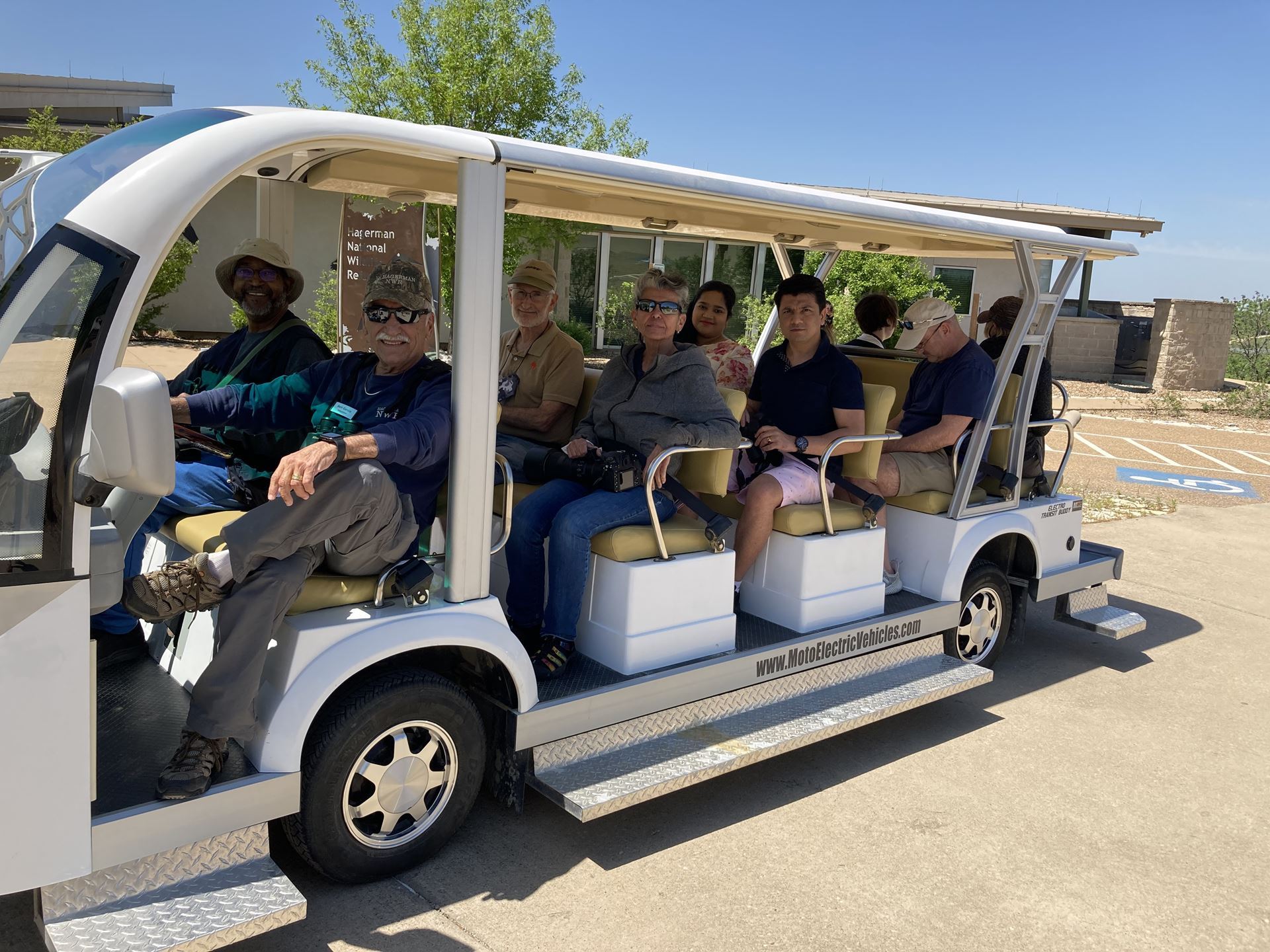
|
|
Register for a Tram Tour Today! |
Do You Like to Work Outside? The Refuge Needs You!
It takes a lot of people to have a beautiful garden! The Wednesday Garden Team Love to work with native plants and meet other gardeners? Come and help us add plants, weed and mulch our beautiful butterfly garden. Garden Team volunteers get first dibs on thinned native plants as well as access to seeds and cuttings for propagation. Gardeners meet on most Wednesdays, but times vary. Contact Us to subscribe to the volunteer garden team weekly email. Provide own tools and gloves. Minimum age 18, or 16 if accompanied by parent/volunteer. Mowing and Refuge Beautification: The Work Crew Do you enjoy working outside, mowing, sprucing up hiking trails, trimming and removing brush and general cleanup? Show your love for nature by joining the Outdoor Crew at Hagerman National Wildlife Refuge. Outdoor Crew volunteers meet on the First Tuesday and Fourth Saturday of every month. Contact Us for exact times, dates and other details about joining the volunteer Work Crew. Scouts welcome! |
Visitor Center Volunteers Needed! |
No pictures to show |
|
| Thank You To Our Contributors: Jack Chiles, Laurie Sheppard, Cindy Steele, Renny Gehman, Cathy Van Bebber Refuge Manager: Kathy Whaley Deputy Refuge Manager: Paul Balkenbush Visitor Services Manager: Spencer Beard Editor: Patricia Crain, Laurie SheppardFriends of Hagerman NWR Foundation 6465 Refuge Road, Sherman, TX 75092 Phone: 903-786-2826 www.facebook.com/FOHNWR |
Search for any word--do not use quotes for phrases |
Kroger: Stop by the customer service desk at Kroger and link your Kroger Card to the Friends of Hagerman: the Friends will get rewards for every dollar you spend, at no cost to you.
Please add info@friendsofhagerman.org to your contacts to ensure delivery of registration confirmations, account information and the Featherless Flyer
See you at the refuge!

